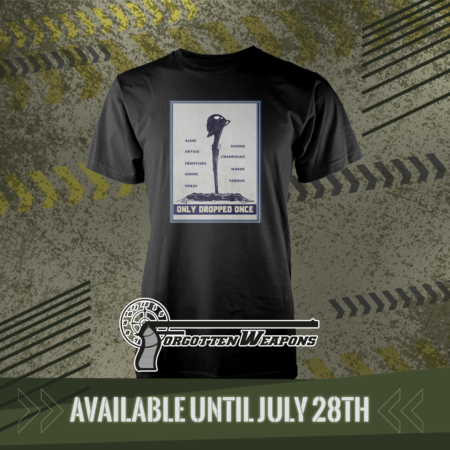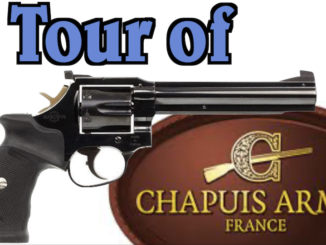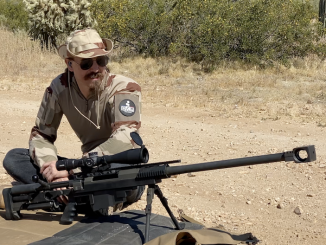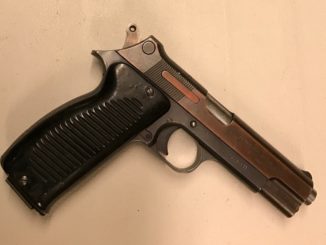When World War One broke out in 1914, France mobilized millions of men into military service – and it became abundantly clear that a lot of new rifles would need to be manufactured. The 1886 Lebel was no longer in production and was a slow rifle to make in any case – but the 1907 Colonial Berthier was being produced already, and was a more efficient design as well. By late 1914, plans were underway to drastically increase Berthier rifle production.
A few changes were made to the 1907 pattern, mainly changing the front end to accept the standard 1886 Lebel bayonet (“Rosalie”). After the first 80,000 had been made, the bolt handle was also changed from the bent carbine style to a heavier duty straight type. With these changes made, the Modele 07/15 was ready for mass adoption by the infantry, where it would serve side by side with the Lebel.
The primary manufacturer of 07/15 rifles was the St. Etienne arsenal, which build between 1.0 and 1.2 million of them by the spring of 1917. The Chatellerault arsenal produced another 436,000, and the Delauney Belleville automobile factory retooled its workshops to make rifles, producing another 170,000 of them. The Remington company in the US also took a contract to make 250,000 Berthier rifles, but was unable to meet the terms of the contract. Remington had taken on more wartime production work than it could handle, and failed to meet French quality and scheduling requirements. In August of 1916 that contract was cancelled, with just 9,440 rifles sent to France for use. The remaining 5,000-10,000 that had been made by Remington were sold on the commercial market in the US.
By 1916, it was clear that the 3-round capacity of the Berthier was a very real disadvantage (both tactically and psychologically) to the German Mauser rifles, and an upgrade program was put underway. This would ultimately become the 1916 pattern and would go into production in 1917.





Again I don’t know if the spike bayonet was useful in tasks other than running people through… a good knife bayonet with a short but sturdy blade makes more sense when going into war. I don’t have to carry extra weight, right?
“Again I don’t know if the spike bayonet was useful in tasks other than running people through… a good knife bayonet with a short but sturdy blade makes more sense when going into war.”
Bayonet choice might be explained by:
logistic – to have one bayonet for Lebel and Berthier rifles
or
doctrine – French 1914 Offensive à outrance or Attaque à outrance which called for attacking, equipping soldiers with longer bayonet might be viewed as morale booster or tool for breaking morale.
Baionnette au canon…
https://www.youtube.com/watch?v=b4Vn1ggjvcI
“Bayonet on the barrel is like the rose on the gun
The flower of the nation going to the slaughter.”
Well, a spike bayonet can be used as an improvised land mine probe almost as well as a knife or sword bayonet, although you can’t dig with it as well. But as I have written here before, most WW1 knife bayonets were still too long and narrow bladed to be really useful as utility knifes. Better of course than a spike bayonet with no cutting edge, but far cry from modern “bayonet-knifes”.
A gruesome, but as far as I can tell, true detail about the combat use of bayonets is that a spike bayonet is less likely to get stuck in someone’s ribcage, because it’s narrower and has no cutting edge that would bite into rib bones. Soldiers were usually taught to go for the stomach rather than chest, but in practical combat that was of course often not feasible.
“utility knifes”
During First World War Germans issued Bayonet M1898/05 sawback:
http://www.gotavapen.se/gota/artiklar/98bayonets/98bayonets2.htm
it was useful as tool, but as it caused terrible wounds if used as bayonet, soldiers caught with such bayonet, might except to be killed on spot, so later saw was removed from it.
The M1898 had a somewhat distinctive widening blade shape, a bit like a machete, although less pronounced, which made it a better chopping tool than your typical sword bayonet. The sawback was also very useful for cutting through branches and such which were too thick to be chopped through. For use as a general utility knife the M1898 was, however, much too long and unwieldy. It had 368mm long blade, which is close to short sword length.
More exotic cutting bayonet was patented by Mondragon:
https://mondragonrifle.com/bayonets/
or using patent name COMBINED WEAPON AND TOOL, which might be used for cutting wood, cutting iron and entrenching.
The main reason the “saw back” was deleted probably had less to do with its potential for getting a Soldat hanged than its potential for breaking the bayonet’s blade.
Bayonets other than epee’-like “pig stickers” saw far more use as utility knives than as spear heads on the business ends of rifles. A utility-type sheath knife was vitally necessary for camp chores from cutting firewood to opening tinned meat. The epee’ bayonet was utterly useless for most such things.
This was known as far back as the Crimea and the American Civil War. One of my ancestors who served with the Ohio volunteer infantry in the latter conflict wrote a letter home that was published in his hometown newspaper, advising new recruits to bring a pocketknife, a knife/fork/spoon combination tool, and a good, strong, fixed-blade sheath knife for such things, as the Model 1861 Springfield rifle-musket’s epee’ bayonet had exactly three practical uses in camp; as a roasting spit, a tent peg, or a candle-holder.
Knife bayonets became moderately common after that, and saw-back blades often appeared on ones for use by sappers and engineers. One example was the “Elcho” bayonet for the Snider-Enfield, named after its designer, Lord Elcho.
The “Elcho” was issued in 1867, and was withdrawn by 1871. The reason? It had a bad habit of breaking the blade in two when used for work requiring any down or side force.
The reason was the saw-back. The process of cutting the saw teeth in as the blade was shaped by stock-removal, plus hardening and tempering, invariably resulted in microcracks and stresses in the blade steel. Over time, with stress and torsion, these resulted in blade failure, i.e. the blade broke in two. This was to prove characteristic of most if not all “saw-back” bladed knives with blades much over 6-8 inches (15-20cm) in length and a width under 2in (5cm).
It’s worth noting that the U.S. Army and Marines Corps never issued “saw-back” bayonets or even “pioneer” blades (like the M1909/17 Bolo or the Model 1904 Hospital Corps Knife, basically a “bolo” with a rounded tip). They all had relatively flat “spines” both to permit “batoning” (using a piece of wood like a “ball bat” to power the blade through when splitting firewood) and to strengthen the blade against bending or breaking.
The best guess as to why the relatively narrow M98 Mauser bayonet with a saw back didn’t last long was most likely due to it also having a propensity for breakage, precisely due to those saw teeth.
As for “bayonet fighting”, the British, French, and German armies all put great emphasis on it early in World War One, but soon found that it was largely irrelevant on the actual battlefield. Simply put, there wasn’t enough room in a trench to maneuver a rifle much longer than an SMLE even without a foot and a half of steel stuck on the front end, and once you were out of the trenches, rifle and machine gun fire resulted in a firefight long before you reached bayonet “range”. A fact the American forces had learned from 1861 to 1865, even with single-shot, muzzleloading rifle-muskets.
I suspect that most “bayonet wounds” seen in the Flanders trenches were inflicted by a bayonet in a soldier’s hand, not on the bayonet mount of his rifle.
Incidentally, a great-uncle of mine who served in The Great War said that the “trench shotguns” with bayonet mounts were about the only effective bayonet weapons in use. Because they were short enough to maneuver in a trench even with the bayonet in place. But the bayonet rarely was used for skewering a German soldier, according to him.
Rather, when going ’round a traverse in the dark, shotgun muzzle first, any German trying to grab the barrel of the weapon and wrest it from your control ended up grabbing a foot or so of very sharp steel instead. And sometimes losing a couple of fingers in the process.
cheers
eon
I strongly suspect that most people bayoneted in WWI were either wounded by artillery, grenades, and bullets before being dispatched, or were skewered while trying to surrender.
Anecdotes I’ve read about from the Meuse Argonne had German “light” machinegunners with the Maxim 08/15 (well, ‘lighter’ anyway…) firing all of the issue ammunition at their position, and when out of cartridges, standing up, raising their hands and greeting Yank doughboys with ‘Kamerad!’… whereupon they were stabbed to death with bayonets by outraged and bloodied attackers.
Similar as Mauser but without serrations, was A-H M95 bayonet. It was very different approach to French design. However, from what I heard from my grandpa, soldiers used with favour “storm knife”, not long and unwieldy bayonet. Apparently, in real ‘life’ on front it was often very close encounter.
http://www.shopbulgaria.com/files/products/cache/w_1427889169_5000_4000_1427889169.jpg
I’ve read accounts that the 1886 Epee bayonet made a useful hook to hang ones kit on when stuck into the side of a trench!
(Incidentally the poilus in Henri Barbusse’s classic “Under Fire” show a particular contempt for the REMF “Halfwits” who have never had to use a bayonet but are happy to call one “Rosalie” when blustering how they would show the Hun a thing or two, if it wasn’t for the awful hernia that keeps them out of the trenches…)
The French made gun here looks to have had something ground off under the markings?
Your French is atrocious but getting better.
Weapon of choice scenario:
Given a choice of salvaged weapons in the dark trenches, which seems the best in the event you must evade savage bandits for 2 hours?
1. Spike bayonet (in hand, not on the rifle), sword bayonet, or knife bayonet
2. Cavalryman’s saber or Gasser-Montenegrin revolver
3. Cudgel/club
4. Sharpened shovel/pickaxe
5. Bootlace garrote
6. Reihenfeuer 08 (full-auto Luger with drum magazine)
7. Ruby Plus Ultra with suppressor
8. Remington Model 10 trench gun with bayonet
9. Kar98AZ
10. Hotchkiss M1909
11. Fedorov Avtomat
12. Grenade crossbow
13. Get something else!!
This is totally voluntary. You aren’t required to participate or respond if you don’t wish to do so. Please keep any and all criticism humane and free of foul language.
Thank you,
Cherndog
The Remington or any other trench shotgun, with or without a bayonet, is the hands-down winner for close-quarters work. A load of buckshot isn’t the “100% guaranteed stopper” in reality that it is in movies, but that or a slug load or “punkin ball” makes a very big hole in the target at trench ranges (generally under five feet), and even when it’s empty it’s still a useful club when used in quarterstaff style. In that respect, having the bayonet mounted would be useful, as it could actually be used for thrusting in addition to slashing.
Next to the shotgun, or as a backup to it, I’d use the Parabellum with the Trommelmagazin, minus the stock. I could always leave it on single-shot until I wanted to attract a lot of attention. Or just shove its muzzle round a corner, go to full-auto, and sweep the trench with 28 rounds of 9mm “weedkiller”. Assuming it fed reliably, which was questionable. The regular 8-round magazines made more sense, especially if you only loaded 7 rounds in them.
Never mind the grenade crossbow, just give me the grenades. Mills Bombs, for a preference, as they were easier to throw than anybody else’s and more importantly, their time fuze igniter sets were reliable both in detonation and timing; unlike some others that might either not go off at all, or go off in a second or so after the pin was pulled. (Grenades with friction igniters, notably the French ones, had a bad habit of this.)
If you are out to wreck the trench and cause as much damage as possible before “going home”, which was the object of most trench raids, a satchel charge is always a handy thing to have, as well.
Oh, BTW- forget the shoestring garrote. They tend to break. A two foot length of communications wire with the ends twisted around a couple of pieces of wood for handles works better. Although as far as silently removing a trench sentry goes, dropping him with a buttstroke to the back of the neck, just below the helmet rim, generally breaks the spine above the fourth or fifth cervical (neck) vertebrae, which is almost instantly fatal about 90% of the time. Or just use the bayonet, in your hand, in the Fairbairn/Sykes method;
http://judoinfo.com/wp-content/uploads/2016/07/pdf/tough.pdf
Any way you look at it, trench fighting is just plain nasty.
cheers
eon
“13. Get something else!!”
Considering that “trenches”, all “full-size” rifles are no go. Too long for usage in cramped space.
Considering that “dark”, all “full-power” rifle cartridge are no go. Flash might blind user, and additionally, you might have cartridge able to hit target 1000 m aways, but having chance to use it like that is very low.
Thus Winchester Model 1907 in select-fire variant with long magazine seems to be good option.
Or maybe go with weapons specifically designed for such environments – namely sub-machine guns, for example Thompson Annihilator:
http://imgur.com/MP7dxcK
it lack well-known, from 1930s movies, drum magazine, but this mean it is lighter and probably less noise.
Here’s an interesting and short article on typical trench-fighting weapons, complete with photos;
https://owlcation.com/humanities/World-War-1-History-Adapting-Weapons-to-Trench-Warfare
It’s worth noting that it was trench warfare that brought the mortar back into the military arsenal as a major item, except this time as a lightweight, relatively short-ranged squad-level infantry support weapon, rather than a huge “piece of emplacement” intended for hammering fortresses or cities flat with indirect fire during sieges.
cheers
eon
“Here’s an interesting and short article on typical trench-fighting weapons, complete with photos”
Good overview, but I would add one forgotten-and-revived weapon: flamethrower (only mentioned briefly in shotgun chapter) dating back to at least so-called Greek fire, similar to mortars, in more portable “package” – firstly in form of Kleif (small flamethrower) operated by two men and later in form of Wex (Wechselapparat) which needed single operator: http://www.kaiserscross.com/40029/76401.html
is: “(…)similar to mortars, in more portable “package”(…)”
should be: “(…)similarly to mortars revived in more portable “package”(…)”
To answer Cherndog’s query: My idea of WWI behavior to emulate would be to join private Svejk’s “Anabasis” *away* from the front with all due dispatch!
The French were even more short of knives than other types of weapons… Factory second epee bayonets were often turned into stabbing weapons. Then there is the “clous francais” or “trench nail.” Even boarding daggers from the age of sail and kitchen chef knives were, erm, “repurposed” for the slaughter. As for infantry arms if I faced the sorts of officers portrayed in, say, *Paths of Glory*–make mine a genuine U.S. Pistol, cal. .30 model of 1918, aka the Pedersen device, with 400 cartridges. Perversely, since I don’t have a throwing arm, they’d probably put me in with the grenadiers… Maybe the “Tromblon” atop a Berthier or a Lebel? I’m short, so perhaps I’d be condemned, um, “seconded” to be a clay kicker deep underground tunneling away unwittingly toward an enemy sapper’s “camouflet.”
Back to the Berthier 07/15: I had no idea that the “new and improved” M16 version arrived at the front as early as 1917? I thought late in 1918. Remington also made the 8x50mm Lebel-caliber Rolling block. At my age, had my genes knit together in WWI, I’d probably be working on one of the narrow gauge railways in the “Etappen” or rear echelon, in which case I’d be lucky to have a rolling block in lieu of say, a Gras.
Contemplating French poilus in action, it would seem that the slow loading of the Lebel 86/93 might mean that it was actually used with its magazine cut off? On defense, the rifle is a single loader until the enemy really comes into view, when the magazine is then turned on prior to abandoning the position for a rear trench, or going all mano a mano with boots, fists, sharpened shovels and cudgels? On the offense, the rifle is used as a single shot until the actual assault of enemy pillboxes and dugouts and so on, again when the magazine is turned on?
Given the oddities of French equipment in the war, and the dearth of published material in English as Ian has noted in his stated aim to remedy that insofar as rifles are concerned, I am often wondering about what would have been most practical?
The best approach for France: focus less upon heroics and more upon how to effectively improve your arsenal. There is a difference between the scarred veteran (whether on the front or in the laboratory making stuff for the shooting range) and the whiny loser. One can adapt and learn even if he has lost much but the other plays the blame game, cursing everyone who disagrees with him, and never accepts responsibility for his own shortcomings.
Well, the war began with the best quick-firing field artillery piece, the “Soixante-quinze.” Unfortunately, once things went over to trench warfare and the pantalons rouges had to be discarded or even just covered up like the kepis, the Germans had high-angle howitzers and guns that could rain explosives *into*the shoddily-built-because-believed-temporary French trenches. “How dare the blighters dig a comfy German-style dugout in the sacred soil of the motherland under enemy occupation!” “Mes petits enfants terribles! Pour la France!!!” While the UK had the 1915 shell controversy/scandal, so too did the French: shrapnel ball shells for the 75s had been stocked, but the sheer volume of artillery fire plus the ineffectiveness of the shrapnel in eliminating German enemies in trenches and deep dugouts could not be initially remedied what with few larger guns (take naval pieces off ships and put them on railway cars!), and a lack of high explosive what with France’s coal producing regions under enemy occupation (U.S. contracts!)
Recall that the French made their own approaches toward restoring fire and movement at a time when Kitchener’s “Pals” couldn’t be trained all that well or completely given the extreme need to replace losses and so at the Somme, for example, the French were more effective in many instances than the 2nd iteration of the BEF… Also, when the French realized that many of their rushed-into-production tank designs were not all that good, there was a conversion of many into a sort of armored resupply vehicle to deliver munitions and supplies to troops that formerly would have had to withdraw. And the FT-17 Renault light tank did pioneer the “modern” turreted tank. The Tromblon grenade launcher was one of the best grenade launchers of the war, and in other types of weapons, the French made important developmental “improvements to the arsenal.” On the other hand, this coincided with some really extemporized “work arounds” that beggar belief.
“take naval pieces off ships and put them on railway cars!”
Or wheeled carriage: http://www.passioncompassion1418.com/Canons/Eng_AfficheCanonGET.php?IdCanonAffiche=730
“One can adapt and learn even if he has lost much but the other plays the blame game, cursing everyone who disagrees with him, and never accepts responsibility for his own shortcomings.”
It is more probable that loser with adapt new solution after war than winner.
After all has to answer: why we lose? When winner can say: we win, why to change anything?
I never said that the veteran was the winner. The good loser learns from his losses while the whiny loser keeps doing the same thing over and over despite the fact that the approach the whiner takes will not work. Look at Qing-dynasty China during the Opium Wars and the First Sino-Japanese War. The Chinese used the same strategy each time, sending warlord armies to “sword it out” against “foreign dishonorable bandits who do not submit to the emperor.” The British got out big guns (long range towed artillery and good infantry rifles, and ship cannons) and so did the Japanese (the Battle of the Yalu River was little more than shooting fish in a barrel). The Chinese did not seem to learn until a long time afterwards, since they implicitly insisted on fighting by the rules of the feudal days… well, the dowager empress never admitted that her embezzlement of arms development funds contributed to defeat. Did I mess up?
“focus less upon heroics and more upon how to effectively improve your arsenal.”
French forces surely have in 1914 commanders which believed in “old-style” warfare, but it must be noted that also have commanders with much more modern approach like général Jean Estienne: https://en.wikipedia.org/wiki/Jean_Baptiste_Eugène_Estienne
I doubt the magazine cutoff would be used while attacking. I would say the most sensible approach would be to load full 10 rounds, shoot only a little while moving across the no man’s land and save a couple of rounds for the unlikely event you would actually reach the enemy trenches without becoming a casualty. When you inevitably run out of loaded ammo, use the bayonet (or whatever close combat weapon you prefer).
Great post! Have nice day ! 🙂 wnjba